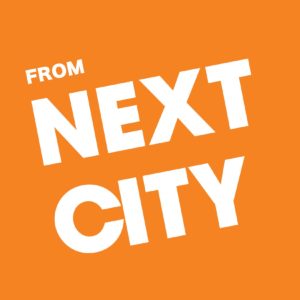By Oscar Perry Abello, Next City, August 24, 2021.

Every Tuesday and Thursday, from 4 p.m. to 6:30 p.m., Nakia Woods has a meeting to help plan for the future of Oakland.
Woods is the program director at HOPE Collaborative — the acronym stands for “Health for Oakland’s People and Environment.” Those are the regular meeting times for the group’s Youth Action Board, which for the past 10 years has brought together Oaklanders aged 14 to 24 from disinvested and marginalized neighborhoods across the Bay Area city.
“Houseless folks, queer folks, folks of color, young people, folks that are differently abled, there’s this misconception that these folks don’t really care about the general plan or city planning process,” says Woods.
Woods recently witnessed Youth Action Board members and other marginalized groups coming together around planning for the future of their neighborhoods. HOPE Collaborative was one of 12 community-based organizations that partnered with the city to lead the East Oakland Neighborhoods Initiative.
From November 2018 to June 2019, the East Oakland Neighborhoods Initiative organized a series of 20 meetings in six neighborhoods across what’s known as “Deep East Oakland” — all historically working-class, predominantly Black and brown neighborhoods that have born the brunt of earlier city planning decisions that have kept them in the path of toxic fumes, water contamination, and other pollution. The results were a laundry list of 89 projects and policies residents would like to see funded and implemented, as well as closer connections between all 12 participating organizations.
Oakland now has a once-in-a-generation opportunity to call upon networks and conversations like those, all across the city and not just in Deep East Oakland, as the Oakland planning bureau begins the process of updating the city’s General Plan. It’s a document that guides city zoning and land-use decisions and capital investments for the next few decades. The general plan determines what can be built where, shaping almost every aspect of a city’s built environment. Oakland’s current general plan was adopted back in 1998, though parts of it were updated in 2013.
HOPE Collaborative and more than 30 other Oakland community-based groups joined forces to submit “The Oakland People’s Plan,” a joint proposal in response to the city’s RFP in search of an outside consulting group to lead the General Plan update process. The collective, cobbled together in just a few weeks, was one of three finalists to deliver a detailed presentation to city planning staff in July. It’s almost certainly the only one with cartoons.
“Honestly it was a little bit overwhelming, learning about what the general plan is, learning about the possibilities of what could happen, learning about the implications of a general plan that is not equitable,” says Woods. “But business as usual has not worked for us. Business as usual really to me means non-authentic engagement or engagement only with people who are already at the table and involved with city processes and don’t understand the complexities that Oakland residents face, don’t understand racial equity, don’t understand gentrification, and having to move out of a city some have called home for generations.”
The Oakland People’s Plan promises to be different. In a typical arrangement, the city would hire a consulting firm with planning experience to lead the process, and then that firm might subcontract community groups to facilitate community engagement. Instead, under the Oakland People’s Plan, 30 groups propose to lead the process as a collective, with private sector planning firms subcontracted to serve as technical advisors for the collective of community groups.
Each community group would establish their own processes to surface ideas from residents, in partnership with others as needed, while also working with technical advisors to translate those ideas into planning and policy language. And community groups would get fair compensation for all that work, which often goes unpaid or underpaid as subcontractors. In fact, under the current Oakland People’s Plan, every person or organization would get paid the same amount — $60.76 per hour, an amount that covers the hourly living wage for 1 adult supporting 1 child in Alameda County, plus 25 percent for overhead.
And rather than coming up with a plan that states exactly what the city will do over the next few decades (which the city of Oakland asked for in its request for proposals), as a final product the Oakland People’s Plan proposes to produce a “minimum viable plan” that satisfies the legal requirements of a general plan in California while establishing and leaving open stronger avenues for residents to surface ideas that the city can implement over time.
“We’re trying to hold our ground by not defining the entire process upfront or acting like it’s our job to do that,” says Janelle Orsi, staff attorney and co-founder at the Sustainable Economies Law Center, which helped convene the collective starting in May. “What we’re defining instead is a participatory process we’re going to facilitate, giving a lot of examples on how it might play out. We’re treating the budget more like a menu that we could all order off of, as opposed to a budget of exactly what we’re going to do.”
If the city of Oakland chooses the Oakland People’s Plan, it’ll be a stark departure from how comprehensive plans often get made.
Even urban planning schools don’t always teach the history of how and why general plans or comprehensive plans became a common practice among cities. An article in the February 1996 issue of the “Land Use Law & Zoning Digest” tells the story of how future President Herbert Hoover, as Secretary of Commerce in the early 1920s, used the department’s resources to encourage local governments to take up the power of zoning and land-use policy.
 Hoover believed that cities needed to take charge of regulating land use to protect home values from the threats of pollution and overcrowding (never mind that cities also once tried to segregate Black people using some of the earliest zoning laws). His department drafted model legislation for states to adopt that would delegate and protect local governments’ powers over zoning and planning.
Hoover believed that cities needed to take charge of regulating land use to protect home values from the threats of pollution and overcrowding (never mind that cities also once tried to segregate Black people using some of the earliest zoning laws). His department drafted model legislation for states to adopt that would delegate and protect local governments’ powers over zoning and planning.
Released in 1922, the committee’s third draft of the “standard state zoning enabling act” first contains the phrase, “such zoning regulations shall be made in accordance with a comprehensive plan.” The draft did not define what a comprehensive plan was, though it did explain in a footnote that its purpose was to “prevent haphazard or piecemeal zoning.” What the model legislation drafts did was to encourage a very technocrat-oriented process, keeping it out of the hands of politicians who were seen as less trustworthy at the time.
By 1935, according to the article, more than 35 states had adopted legislation for zoning or planning based on standard drafts from Hoover’s advisory committee on zoning. Not every state passed the same exact legislation. Some passed legislation requiring cities to create a comprehensive plan or master plan that would underlie zoning ordinances, others didn’t. New York City, famously (or infamously), has a 3,300-page zoning resolution [PDF, 131 MB] but does not have a comprehensive plan.
California’s Government Code Section 65300 requires counties and cities in the state to create a general plan and to update it every so often. Failure to do so can result in cities losing out on state funding for housing, economic development, transportation, and other infrastructure needs. Section 65302 outlines required general plan elements for chartered cities in California, of which there are currently 86 — including Oakland.
The last time Oakland updated its general plan was in 1998, but it took a four-year process to get to that point. At the time, Iris Starr was the Oakland planning bureau’s strategic planning manager overseeing the process.
“Now when I look back, at the time I was really naive,” says Starr, who is now retired but still living in Oakland. “I’d been fully indoctrinated in the ways of city planning and zoning. I had no understanding of who was really being left out, or why, and how critical that was.”
At the start of the process, the city contracted the services of a private firm to do the bulk of the drafting work. “It was a big firm and well-regarded in planning circles at the time, but the firm was all white,” Starr says, a big contrast from Oakland’s population at the time, only 23.5 percent white non-Hispanic.
The city also established a 33-member “General Plan Congress,” mostly political insiders appointed by the mayor and city council members. According to Starr, for the next four years, the General Plan Congress and the consulting firm would often spend daytime hours hashing out bits and pieces of the plan. Meanwhile, it was left to city planning staff to go out and gather input from community members, often on evenings and weekends.
“And the communities I went to were largely middle class, largely white, and very interested in this idea of the general plan either because it was going to support growth and development or restrict growth and development,” says Starr. “When I think back, the intention really was to push every potentially bad outcome down to what we called the Flatlands.”
The Flatlands encompasses both West Oakland and Deep East Oakland, so named for their lower-lying, flatter landscape next to the waterfront with its heavy industrial and port infrastructure. During World War II, these areas became home to a huge influx of Black migrants from the South, who left as part of the Great Migration in search of job opportunities tied to the war mobilization.
As Black families moved in, white families were encouraged to take government-supported mortgages and buy homes elsewhere in exclusively-white neighborhoods, including up in “The Hills” — the part of Oakland that is further inland, higher up and away from pollution and port congestion, and today both wealthier and predominantly white. The General Plan came to limit development in the Hills while encouraging development elsewhere in Oakland.
“The [1998] General Plan really became a plan about where we were going to let developers go wild,” says Starr.
Oakland released its RFP for a lead or “prime” consultant for its general plan update in May of this year. During a May 11 virtual meeting to kick things off, attendees representing various community groups raised concerns about whether there was sufficient time and space for genuine community engagement or even community leadership. The initial deadline to submit a response to the city’s RFP for a lead consultant was only two weeks after that meeting.
City planners encouraged community groups represented in the kickoff meeting to reach out to potential lead consultants — the large firms with strong reputations and extensive track records in urban planning — to establish relationships as potential subcontractors that could take the lead on community engagement in certain neighborhoods or to certain communities. It was even suggested that community groups establish such relationships with more than one consulting firm.
But multiple community group representatives argued during the kickoff meeting that two weeks was not nearly enough time to meet with firms they’d never met before and build the level of trust required for them to sign dotted lines on MOUs or subcontracting agreements with private sector planning firms.
In response to those concerns, the city extended the deadline for submissions twice, finally to June 25, and it also released a second RFP for a community engagement lead.
But the Oakland People’s Plan collective doesn’t want the community engagement lead. It wants the prime consulting contract for the general plan update.
“What it felt like to us is they were on a path to that point to hire a for-profit planning firm, and then at some point after the city and the planning firm had defined the whole process, get some nonprofit to organize some other nonprofits to get input or feedback,” Orsi says.
Challenges with general plan processes in California are well known, from exorbitant costs to challenges finding and accessing relevant data. In 2017, the Governor’s Office of Planning and Research updated its general plan guidelines [PDF, 7.3 MB], a sort of user-manual for how to go through the process in a more streamlined and hopefully less costly fashion, while also incorporating state priorities like environmental justice and climate change mitigation. The release was coupled with a new data-mapping tool designed specifically to help California cities update general plans. As of 2015, more than half of California cities had a general plan that was more than 15 years, according to the guidelines.
The Oakland People’s Plan collective knew they still needed planning chops on their proposal. And they wanted consultants and experts who would be willing to be a subcontractor to them instead of the other way around. Turns out, those experts were not that hard to find. Some of the experts signing on with the collective as potential subcontractors are Marquita Price, known as the “Hood Planner,” who helped lead the East Oakland Neighborhoods Initiative as the director of urban and regional planning for the East Oakland Collective; Rincon Consultants, offering experience in California’s environmental review process; and also Farallon Strategies, whose founder and president Michael McCormick, AICP, was one of the principal co-authors of California’s 2017 general plan guidelines.
“I feel kind of hopeful and scared, skeptical that the city will accept something new,” says Starr. “Why would the city want to give up power? The department heads, city administrators, I don’t know what would compel them to do the right thing. The weight of white supremacy is just so much and so deep, people talk about equity but they don’t have a deep understanding of what that means.”
The Oakland planning bureau’s general plan update page says the agency will announce who won the contract in September.
“It would be a lot of work, years of work, then years of work with the zoning to implement the plan,” Starr says. “It doesn’t end for anybody, but it never starts for people on the margins.”
[Ed. note. As of September 27, a month since this article was written, the process has moved along. Toward “a comprehensive, collaborative, accessible, inclusive, and equity-driven public engagement approach,” the City will be engaging two consulting teams. One team, comprising nine firms, will provide general plan technical services. A second team, comprising 11 Oakland-based community organizations, will provide community consulting engagement services. This approach, together with the recommendations of two selection committees, will be considered at the Oakland City Council on October 5. See the Oakland Legistar calendar and stay tuned.]
This article was originally published on August 24 in Next City’s The Bottom Line, a series exploring scalable solutions for problems related to affordability, inclusive economic growth, and access to capital. Republished with permission. Iris Starr, who is quoted liberally in the article, was an AICP member of APA California Northern until 2011. She worked for the City of Oakland for eight years in strategic planning (1991-1999) and 10 years in transportation planning (2008-2018). Starr holds an MCRP and an M.Arch from UC Berkeley.
 Oscar Perry Abello, who has been with Next City for six years, is their senior economics correspondent. He was Next City’s editor from 2018-2019. Since 2011, Abello has covered community development finance, community banking, impact investing, economic development, housing, and more for various media outlets, including Fast Company.
Oscar Perry Abello, who has been with Next City for six years, is their senior economics correspondent. He was Next City’s editor from 2018-2019. Since 2011, Abello has covered community development finance, community banking, impact investing, economic development, housing, and more for various media outlets, including Fast Company.

